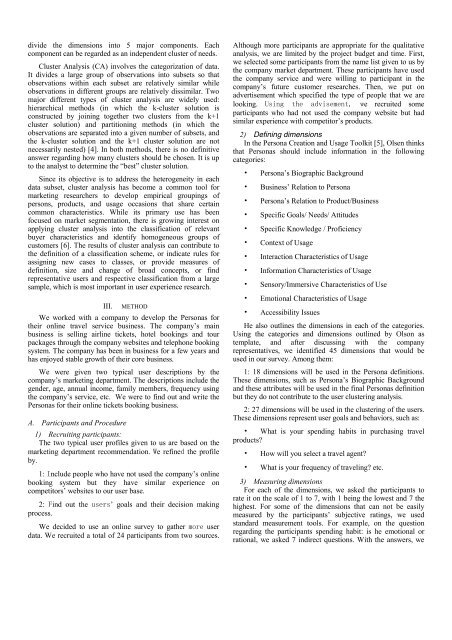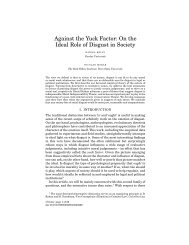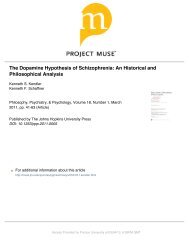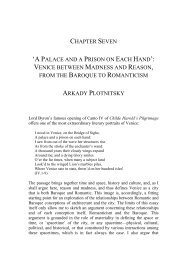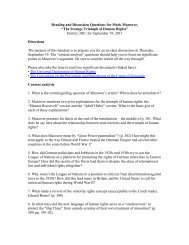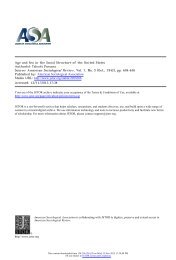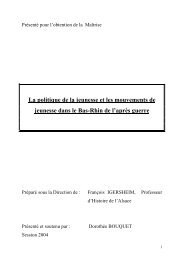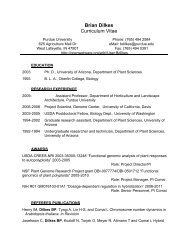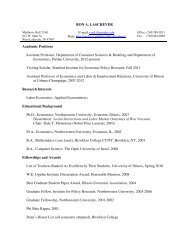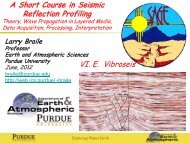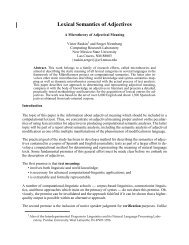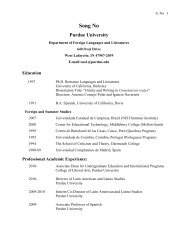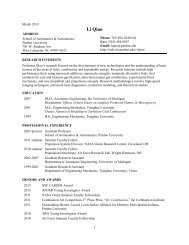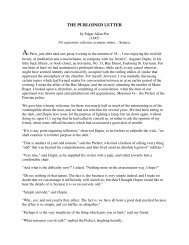Using Cluster Analysis in Persona Development
Using Cluster Analysis in Persona Development
Using Cluster Analysis in Persona Development
You also want an ePaper? Increase the reach of your titles
YUMPU automatically turns print PDFs into web optimized ePapers that Google loves.
divide the dimensions <strong>in</strong>to 5 major components. Each<br />
component can be regarded as an <strong>in</strong>dependent cluster of needs.<br />
<strong>Cluster</strong> <strong>Analysis</strong> (CA) <strong>in</strong>volves the categorization of data.<br />
It divides a large group of observations <strong>in</strong>to subsets so that<br />
observations with<strong>in</strong> each subset are relatively similar while<br />
observations <strong>in</strong> different groups are relatively dissimilar. Two<br />
major different types of cluster analysis are widely used:<br />
hierarchical methods (<strong>in</strong> which the k-cluster solution is<br />
constructed by jo<strong>in</strong><strong>in</strong>g together two clusters from the k+1<br />
cluster solution) and partition<strong>in</strong>g methods (<strong>in</strong> which the<br />
observations are separated <strong>in</strong>to a given number of subsets, and<br />
the k-cluster solution and the k+1 cluster solution are not<br />
necessarily nested) [4]. In both methods, there is no def<strong>in</strong>itive<br />
answer regard<strong>in</strong>g how many clusters should be chosen. It is up<br />
to the analyst to determ<strong>in</strong>e the “best” cluster solution.<br />
S<strong>in</strong>ce its objective is to address the heterogeneity <strong>in</strong> each<br />
data subset, cluster analysis has become a common tool for<br />
market<strong>in</strong>g researchers to develop empirical group<strong>in</strong>gs of<br />
persons, products, and usage occasions that share certa<strong>in</strong><br />
common characteristics. While its primary use has been<br />
focused on market segmentation, there is grow<strong>in</strong>g <strong>in</strong>terest on<br />
apply<strong>in</strong>g cluster analysis <strong>in</strong>to the classification of relevant<br />
buyer characteristics and identify homogeneous groups of<br />
customers [6]. The results of cluster analysis can contribute to<br />
the def<strong>in</strong>ition of a classification scheme, or <strong>in</strong>dicate rules for<br />
assign<strong>in</strong>g new cases to classes, or provide measures of<br />
def<strong>in</strong>ition, size and change of broad concepts, or f<strong>in</strong>d<br />
representative users and respective classification from a large<br />
sample, which is most important <strong>in</strong> user experience research.<br />
III. METHOD<br />
We worked with a company to develop the <strong>Persona</strong>s for<br />
their onl<strong>in</strong>e travel service bus<strong>in</strong>ess. The company’s ma<strong>in</strong><br />
bus<strong>in</strong>ess is sell<strong>in</strong>g airl<strong>in</strong>e tickets, hotel book<strong>in</strong>gs and tour<br />
packages through the company websites and telephone book<strong>in</strong>g<br />
system. The company has been <strong>in</strong> bus<strong>in</strong>ess for a few years and<br />
has enjoyed stable growth of their core bus<strong>in</strong>ess.<br />
We were given two typical user descriptions by the<br />
company’s market<strong>in</strong>g department. The descriptions <strong>in</strong>clude the<br />
gender, age, annual <strong>in</strong>come, family members, frequency us<strong>in</strong>g<br />
the company’s service, etc. We were to f<strong>in</strong>d out and write the<br />
<strong>Persona</strong>s for their onl<strong>in</strong>e tickets book<strong>in</strong>g bus<strong>in</strong>ess.<br />
A. Participants and Procedure<br />
1) Recruit<strong>in</strong>g participants:<br />
The two typical user profiles given to us are based on the<br />
market<strong>in</strong>g department recommendation. We ref<strong>in</strong>ed the profile<br />
by.<br />
1: Include people who have not used the company’s onl<strong>in</strong>e<br />
book<strong>in</strong>g system but they have similar experience on<br />
competitors’ websites to our user base.<br />
2: F<strong>in</strong>d out the users’ goals and their decision mak<strong>in</strong>g<br />
process.<br />
We decided to use an onl<strong>in</strong>e survey to gather more user<br />
data. We recruited a total of 24 participants from two sources.<br />
Although more participants are appropriate for the qualitative<br />
analysis, we are limited by the project budget and time. First,<br />
we selected some participants from the name list given to us by<br />
the company market department. These participants have used<br />
the company service and were will<strong>in</strong>g to participant <strong>in</strong> the<br />
company’s future customer researches. Then, we put on<br />
advertisement which specified the type of people that we are<br />
look<strong>in</strong>g. <strong>Us<strong>in</strong>g</strong> the advisement, we recruited some<br />
participants who had not used the company website but had<br />
similar experience with competitor’s products.<br />
2) Def<strong>in</strong><strong>in</strong>g dimensions<br />
In the <strong>Persona</strong> Creation and Usage Toolkit [5], Olsen th<strong>in</strong>ks<br />
that <strong>Persona</strong>s should <strong>in</strong>clude <strong>in</strong>formation <strong>in</strong> the follow<strong>in</strong>g<br />
categories:<br />
• <strong>Persona</strong>’s Biographic Background<br />
• Bus<strong>in</strong>ess’ Relation to <strong>Persona</strong><br />
• <strong>Persona</strong>’s Relation to Product/Bus<strong>in</strong>ess<br />
• Specific Goals/ Needs/ Attitudes<br />
• Specific Knowledge / Proficiency<br />
• Context of Usage<br />
• Interaction Characteristics of Usage<br />
• Information Characteristics of Usage<br />
• Sensory/Immersive Characteristics of Use<br />
• Emotional Characteristics of Usage<br />
• Accessibility Issues<br />
He also outl<strong>in</strong>es the dimensions <strong>in</strong> each of the categories.<br />
<strong>Us<strong>in</strong>g</strong> the categories and dimensions outl<strong>in</strong>ed by Olson as<br />
template, and after discuss<strong>in</strong>g with the company<br />
representatives, we identified 45 dimensions that would be<br />
used <strong>in</strong> our survey. Among them:<br />
1: 18 dimensions will be used <strong>in</strong> the <strong>Persona</strong> def<strong>in</strong>itions.<br />
These dimensions, such as <strong>Persona</strong>’s Biographic Background<br />
and these attributes will be used <strong>in</strong> the f<strong>in</strong>al <strong>Persona</strong>s def<strong>in</strong>ition<br />
but they do not contribute to the user cluster<strong>in</strong>g analysis.<br />
2: 27 dimensions will be used <strong>in</strong> the cluster<strong>in</strong>g of the users.<br />
These dimensions represent user goals and behaviors, such as:<br />
• What is your spend<strong>in</strong>g habits <strong>in</strong> purchas<strong>in</strong>g travel<br />
products?<br />
• How will you select a travel agent?<br />
• What is your frequency of travel<strong>in</strong>g? etc.<br />
3) Measur<strong>in</strong>g dimensions<br />
For each of the dimensions, we asked the participants to<br />
rate it on the scale of 1 to 7, with 1 be<strong>in</strong>g the lowest and 7 the<br />
highest. For some of the dimensions that can not be easily<br />
measured by the participants’ subjective rat<strong>in</strong>gs, we used<br />
standard measurement tools. For example, on the question<br />
regard<strong>in</strong>g the participants spend<strong>in</strong>g habit: is he emotional or<br />
rational, we asked 7 <strong>in</strong>direct questions. With the answers, we


